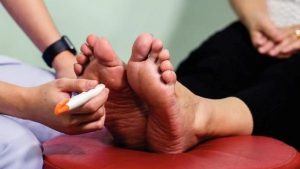Understanding the demographics of diabetes related ulcers and amputations (UNDERSTOOD)

Diabetes is a growing global health problem and diabetic foot disease is one of its most expensive complications. As such we do not have a clear picture of the demographics of this complication. In addition, we need to understand the characteristics of ulcers as well as the incidence and types of amputations for effective clinical management.
Previous research has clearly highlighted the limitations of currently available diabetic foot screening guidelines; which aim to identify patients at risk of foot complications, such as ulcerations and amputations, and who therefore may require mobility assistive devices. Also, there is a lack of consensus on various screening guidelines at both national and international level. This contributes to differences in practice leading to huge variability in diabetic foot disease outcomes and associated burden. Additionally, there is limited high-quality evidence on which these guidelines are based. This is responsible for the current gaps between guidelines, standard clinical practice, and development of complications.
Whilst indicating that diabetes is associated with a clear increase in the risk of physical disability, studies have called for efforts to promote healthy aging and strategies for mitigating this risk through prevention and management. In addition, reports showcase that diabetes related lower extremity complications are one of the leading causative factors in the global burden of disability. Although publicly available datasets provide an overall picture of diabetes, it has little or no information relating to the complications and particularly no data on amputations or mobility related assistive devices. There is a clear need for collecting structured and patient focused data during screening at a primary care level. This, in addition to helping to reduce the complications of the disease, will help to understand the assistive technology needs of these patients.
This Project aims to gather this data which will help us formulate effective health policy and practice tailored to country specific demographics. The areas that we will explore as a part of this project relates to the type and duration of diabetes and the characteristics of its complications. The first stage of the project will aim to collect data at the collaborating institutions listed below. The project will then be expanded with a specific interest on developing and less developed regions of the world.
Principal Investigator and Coordinator: Professor Nachiappan Chockalingam (Staffordshire University, UK)
Co-Investigator(S): Dr Aoife Healy (Staffordshire University, UK)
Collaborators/ Co-Investigators:
- WHO Collaborating Centre for Diabetes Treatment and Education, Diabetes Center, Kyoto Medical Center, National Hospital Organization, Koto, Japan (Dr Shigeo Kono)
- WHO Collaborating Centre for Research, Education and Training in Diabetes, Prof. M. Viswanathan Diabetes Research Centre Diabetes Research Centre and M.V. Hospital for Diabetes. Chennai, India (Dr Vijay Viswanathan)
- Faculty of Health Sciences, University of Malta, Malta (Dr Cynthia Formosa and Dr Alfred Gatt)
- Dr Abbas Medical Centre, Dar es Salaam, Tanzania (Dr Z Abbas)
- Horacio Oduber Hospital, Aruba (Dr Yuri Casseres)

